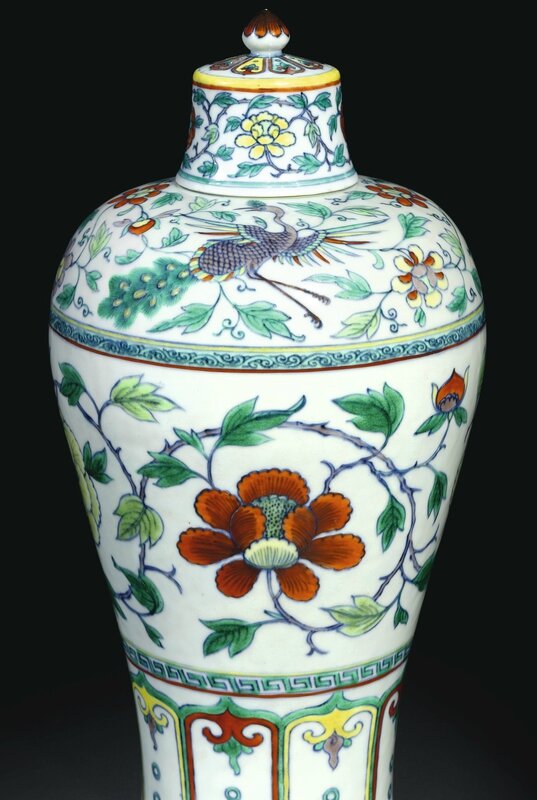A fine, large and brilliantly enamelled doucai 'phoenix and peony' meiping and cover, Qing dynasty, 18th century
Lot 116. A fine, large and brilliantly enamelled doucai 'phoenix and peony' meiping and cover, Qing dynasty, 18th century. Estimate 4,000,000 — 6,000,000 HKD. Photo: Sotheby's.
sturdily potted with a well-proportioned rounded shoulder tapering to a countersunk base and surmounted by a short waisted neck, the body divided into three main registers with three iron-red lines, the central frieze painted with large multi-coloured flowering peony blooms borne on a curling leafy stem meandering across the exterior and bearing floral buds above a band of angular scrolls, the lower body with a band of upright lotus petals enclosing ruyi-shaped lappets, as well as stylised trefoil and circular motifs, all below the broad shoulder decorated with a pair of phoenix soaring amidst further peony scrolls, the mythical creatures vibrantly rendered with fine plumage and multi-coloured tail feathers, between two 'classic' scroll bands, the well-fitted circular cover tapering to a domed top and surmounted by a bud finial, the sides with brightly enamelled peony blossoms wreathed by leafy stems, the top with stylised lotus lappets radiating from the finial, the finial enamelled with slender petals - 38.4 cm, 15 1/8 in.
Notes: Although a few similar meiping vases appear to have survived, it is extremely rare to find one complete with its original cover. A closely related vase of slightly smaller size, but lacking the cover, was sold at Christie's London, 23rd March 1987, lot 405; and another, but the petal lappets encircing the foot enamelled with a yellow ground, was sold in our New York rooms, 8th May 1981, lot 332. Compare also larger meiping of this type, but with a wider lappet band and each filled with a different colour, was sold twice in these rooms, 30th April 1991, lot 128, and 8th October 2010, lot 2685; another sold in our London rooms, 22nd May 1985, lot 191; and a larger example with cover, from the collection of Sir John Buchanan, illustrated in R. Soame Jenyns, Later Chinese Porcelain, London, 1954, pl. 88.
This vase belongs to a special group of wares decorated in the doucai technique produced during the 18th century. Doucaidecoration, whereby the motif is outlined in underglaze blue and coloured over the glaze with enamel, is derived from the cloisonné technique of the Ming period. The technique of producing doucai wares was developed during the Chengua period (1465-87) as can be seen from the wonderful Chenghua chicken cups and stembowls. Doucai wares continued to be appreciated for their understated elegance and for their association with Chenghua porcelain throughout the Qing dynasty and were particularly favoured by the Yongzheng and Qianlong Emperors.
The design and style of rendering the flower scroll on the present meiping reveals the influence of Chenghua originals. The finely pencilled underglaze-blue lines coupled with the stylised flower heads among leafy scrolls are reminiscent of the lotus scroll design found on Chenghua stemcups, such as two pairs, in the National Palace Museum, Taipei, included in The Special Exhibition of Ch'eng-hua Porlceain Ware, National Palace Museum, Taipei, 2003, cat. nos. 171-4, together with an ovoid covered jar decorated with a band of lingzhi fungus scroll between lappet bands, cat. no. 118.
Sotheby's. Important Chinese Art: The Collection of a Parisian Connoisseur, Part III, Hong Kong, 05 Oct 2016, 11:30 AM

/https%3A%2F%2Fprofilepics.canalblog.com%2Fprofilepics%2F1%2F0%2F100183.jpg)
/https%3A%2F%2Fstorage.canalblog.com%2F03%2F02%2F119589%2F96711876_o.jpg)
/https%3A%2F%2Fstorage.canalblog.com%2F11%2F31%2F119589%2F94773502_o.jpg)
/https%3A%2F%2Fstorage.canalblog.com%2F20%2F83%2F119589%2F94772815_o.jpg)
/https%3A%2F%2Fstorage.canalblog.com%2F26%2F72%2F119589%2F75604929_o.jpg)
/https%3A%2F%2Fstorage.canalblog.com%2F59%2F60%2F119589%2F26458628_o.jpg)






/image%2F1371349%2F20240326%2Fob_936d86_104-1.jpg)
/image%2F1371349%2F20240326%2Fob_823710_102-1.jpg)
/image%2F1371349%2F20240326%2Fob_55a293_101-1.jpg)
/http%3A%2F%2Fstorage.canalblog.com%2F33%2F99%2F119589%2F129627838_o.jpg)